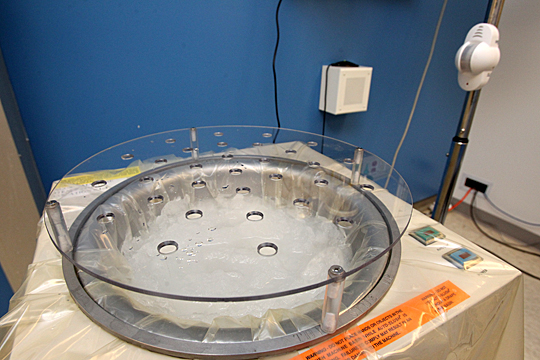In the wake of a human error that resulted in the accidental discarding of a to-be-transplanted kidney from a living donor, The University of Toledo Medical Center has created an array of new tools to increase patient safety. These innovations include a new prototype designed in the last few weeks to ensure the safety of any organ or piece of tissue.

A new prototype device created by biomedical engineers at UT Medical Center covers the slush machine that holds a to-be-transplanted kidney once removed from a donor and sounds an alert when lifted. The alert also sounds if the machine is unplugged. UTMC is experimenting with this prototype as well as infrared motion sensor technology in an effort to create a safer operating room.
“The kidney can only be accessed by removing this cover and when that is done, an alarm sounds, alerting the entire operating room staff that someone is accessing the kidney,” said Dr. Jeffrey P. Gold, chancellor and executive vice president for biosciences and health affairs.
“This device is vented to prevent the buildup of humidity, it can be easily sterilized, and in addition, because of the design, if the slush machine were to be unplugged to be moved, the alarm would sound as well,” said Gold, who also serves as dean of the College of Medicine and Life Sciences.
UTMC clinicians also are utilizing existing technology in a new way by experimenting with placing an infrared sensor next to the slush machine so that an alert sounds if anyone enters a predetermined radius. A brightly colored panel now will cover any tissue being stored in the slush machine to prevent confusion regarding whether an organ or tissue is present.
Gold said the University has been in contact with the maker of the slush machines to see about integrating the changes made by UTMC bioengineers into the unit’s design for hospitals across the nation.
“I would emphasize that we are in the beginning stages of evaluating how these devices would be used in an operating room setting,” Gold said. “But given what we’ve seen so far, we’re very encouraged that these steps could increase patient safety.”
In addition to innovations in the OR, UTMC is using technology to enhance training for all operating room staff — particularly in the area of handoffs between health-care providers.
Using the institution’s Immersive Interprofessional Simulation Center, UTMC has created a video highlighting the correct way for clinicians to relieve one another for breaks or between shifts. Additionally, all staff members have been through handoff training, which now includes written checklists and mandatory signatures.
“We’re also using innovative technology to create 3-D spaces that simulate with a computer program actual UT operating rooms, complete with interactive avatars to help provide realistic training experiences,” Gold said.
“If there can be any silver lining that comes from the regrettable human error we experienced last August, it is the fact that we are learning from our mistakes and sharing that knowledge in such a way that patients and hospitals across the nation and around the world will benefit.”